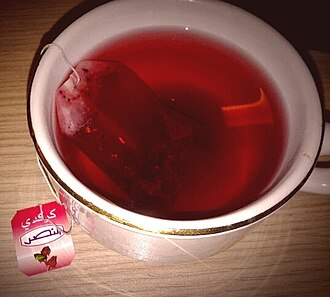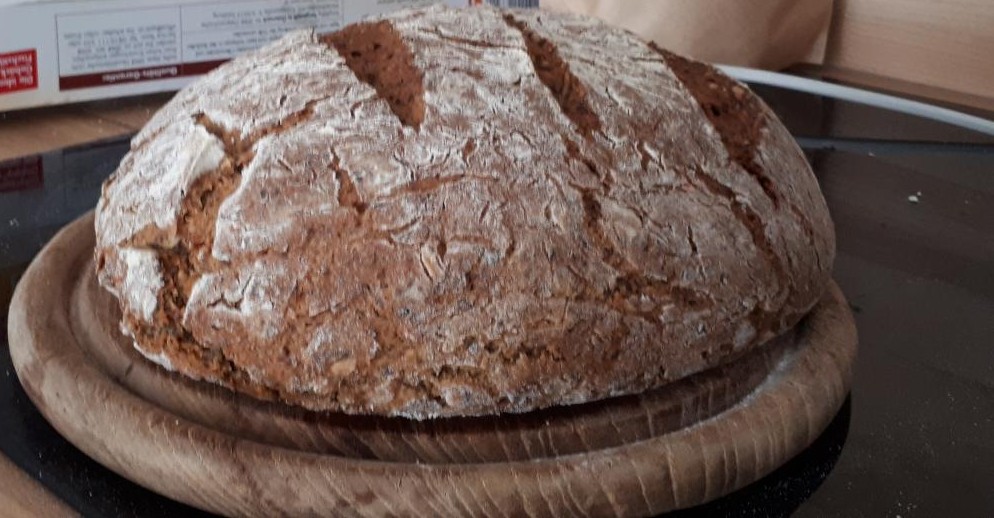Hibiscus tea is a herbal tea made as an infusion from crimson or deep magenta-colored calyces (sepals) of the roselle (Hibiscus sabdariffa) flower. It is consumed both hot and cold and has a tart, cranberry-like flavor.
Consumption: Africa
The roselle hibiscus used to make the tea likely originated in Africa.[1] In Africa, hibiscus tea is commonly sold in markets and the dried flowers can be found throughout West and East Africa. Variations on the drink are popular in West Africa and parts of Central Africa. In Senegal, bissap is known as the "national drink of Senegal". Hibiscus tea is often flavored with mint or ginger in West Africa. In Ghana it is known as "sobolo", and "zobo" in Nigeria.
Karkadé (Arabic: كَركَديه karkadīh pronounced [kɑrkæˈdiːh]) is served hot or chilled with ice. It is consumed in some parts of North Africa, especially in Egypt and Sudan

Consumption: Americas
Agua de flor de Jamaica, also called agua de Jamaica and rosa de Jamaica, is popular in Mexico, Central America, and parts of South America and the Caribbean. It is one of several common aguas frescas, which are inexpensive beverages typically made from fresh juices or extracts. Jamaica and other aguas frescas are commonly found in taquerias or other Mexican restaurants. It is usually prepared by steeping the calyces in boiling water, straining the mixture, pressing the calyces (to squeeze all the juice out), adding sugar, and stirring. It is served chilled, and in Jamaica, this drink is a tradition at Christmas, served with fruitcake or sweet potato pudding

In Panama, both the flowers and the drink are called saril (a derivative of the English word sorrel). It is prepared by picking and boiling the calyces with chopped ginger, sugar, clove, cinnamon, and nutmeg. It is traditionally drunk around Christmas and Chinese New Year. This diverges from Mexico and Central America and is much more in line with the Caribbean, due to the strong West Indian influence in Panamanian culture; especially in Panama City and most of Panama's Caribbean coast.
In the English-speaking Caribbean, the drink, called sorrel, is made from the calyces, and it is considered an integral part of Christmas celebrations. In American soul food cuisine, hibiscus tea is included in a category of "red drinks" associated with West Africa.
Consumption: Southeast Asia
In Thailand, most commonly, roselle is prepared as a cold beverage, heavily sweetened and poured over ice, similar to sweetened fruit juices. Plastic bags filled with ice and sweetened 'grajeab' can be found outside most schools and in local markets. It is less commonly made into a wine.
Reviews have concluded that hibiscus tea consumption appears to modestly lower blood pressure in people with high blood pressure. Hibiscus tea was generally well tolerated, and did not adversely affect liver or kidney function at lower doses, but may be hepatotoxic at high doses.
Hexbear links
- 🐻Link to all Hexbear comms
- 📀 Come listen to music and Watch movies with your fellow Hexbears nerd, in Cy.tube
- 🔥 Read and talk about a current topics in the News Megathread
- ⚔ Come talk in the New Weekly PoC thread
- ✨ Talk with fellow Trans comrades in the New Weekly Trans thread
- 👊 Share your gains and goals with your comrades in the New Weekly Improvement thread
- 🧡 Disabled comm megathread
reminders:
- 💚 You nerds can join specific comms to see posts about all sorts of topics
- 💙 Hexbear’s algorithm prioritizes comments over upbears
- 💜 Sorting by new you nerd
- 🌈 If you ever want to make your own megathread, you can reserve a spot here nerd
- 🐶 Join the unofficial Hexbear-adjacent Mastodon instance toots.matapacos.dog
Links To Resources (Aid and Theory):
Aid:
Theory:


Finding or buying materials for cheap to use in future DIY projects that take an enormous amount of energy to complete is the biggest trap ever. I have a stack of about 1500 paver bricks that I got for free 3-4 years ago sitting in my driveway, finally got around to starting a walkway in the fall. Digging out grass with tons of shallow tree roots and leveling the ground is brutal work and I couldn't get it all done before winter, now it's going to be another 3-4 months of staring at bricks.
Anybody want like 20 pallets of various size, wood type, and state of deconstruction? How about several piles of rocks, ranging from fist-sized to Atlas stone? All of these wonders and more can be found in my driveway, begging to be stolen by a good samaritan.
You could try throwing up a post on something like Craigslist saying they're free to take
I've done this a few times but I prefer to use it only as a last resort. For stuff that nobody really wants (what I have) it takes a lot of time, and unfortunately there is a relatively high potential for some real weirdos to find out where you live.